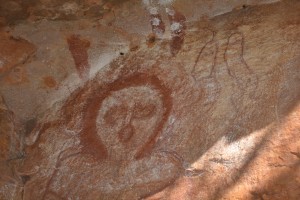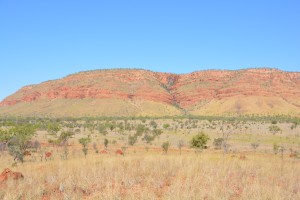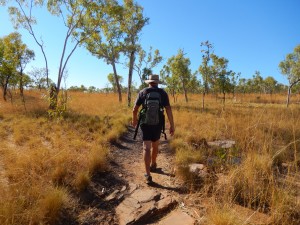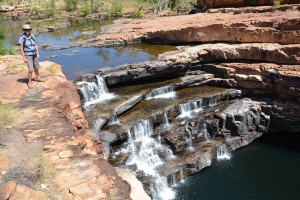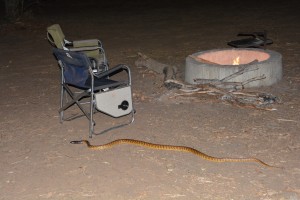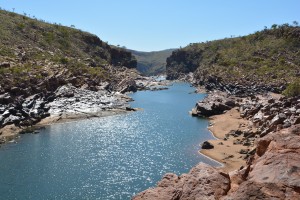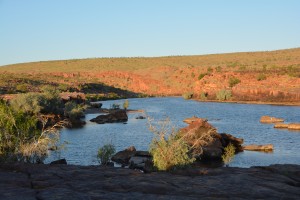Gorging on gorges
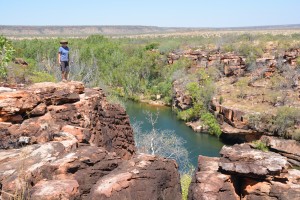
Julie stands all conquering over Barnet River Gorge, one of a dozen we visited in just a couple of days
The western end of the Gibb River Road is dominated by the dramatic King Leopold mountain range, the first true mountains we had seen in some time. Part of an ancient sea bed that has risen over the eons, this rocky range is said to be over two billion years old, making them some of the oldest rocks in the world. The main features of this mountain range are high vertical sandstone cliff walls, ageless rivers that flow through them and flat savannah surrounding them. In other words, perfect for deep and dramatic gorges.
In essence, the gorges are formed over millions of years when rivers gouge a path through the soft sandstone. In fact, in some cases the rivers flowed through these lands before the mountains rose up and were able to retain their original course by continually carving their path with their overpowering wet season flow as the mountains slowly grew. Kind of a strange thought.
Often times the rivers will fall off the mountain cliffs, creating beautiful waterfalls and the inevitable plunge pool at the bottom. Because of the sheer size of the region there were almost uncountable opportunities for water, rock and the passage of time to play out their games. And now we get to enjoy them all in whatever form they take.
Over the few days we explored this region we saw more than a dozen gorges, each carrying their own unique features and each an amazing scene. Some of them, like Galvans Gorge, were very close to the road and required only a short walk in (but required allowing a long startled snake to pass across our path). Others, such as Adcock Gorge, had a short rough track to follow before a short rough walk up the canyon before reaching the waterfall and plunge pool. And in all cases the sun was beating down hot, getting hotter as each day passes, always cloudless and most days in the high 30’s.
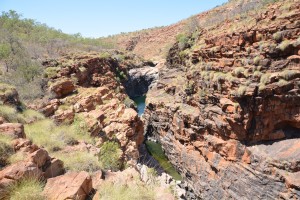
Lennard Gorge was one of the deepest and narrowest but unfortunately almost inaccessible to visitors
Some gorges we could only visit from above, such as Barnet Gorge and Lennard Gorge, which ensured dramatic views but robbed us of the chance to swim or at least cool down. These gorges had high steep red rock walls with waterholes far down below, teasingly out of reach from melting visitors.
Two of the best gorges came on successive days. One day we pulled into Manning Gorge, set up camp near the lower gorge and then walked over and had a beautiful swim from the sandy banks of the clear water. Then we swam across the river, not easy for me as I was holding our daypack with clothes, shoes and camera high above my head, and walked about three kilometres to the upper gorge. This was paradise, only the two of us as the sun set lower on the sky, swimming the length of the big pool and then clamouring over rocks up the dry waterfall until we could reach the higher pool. We walked back to camp as the sun set and beautiful colours splashed across the, melaleucas, spinifex grass and pandanus palms.
The next day we followed a track up a nearby valley to Bell Gorge, a deep five-tiered gorge with the trail finishing at the top pool. We had lunch in the saddest excuse for shade and then climbed up and over the rocks, down the steep slope and into the huge pool the filled the amphitheatre below the main falls. This was a swim to remember, clinging onto the rocks under each of the falls, rinsing off a day’s sweat and dust, cooling the body in the torrid heat. But we then climbed up and down the side of the steep walls to the lower pool and had another swim in a spa-like bowl just above another huge drop off.
The whole experience at Bell Gorge was completed that night around our campfire when a two metre black-headed python slithered out of the bush nearby and went right past our chairs. We usually camp in the dark and don’t like to have bright overhead lights in our camp so this snake was able to sneak up on us and then slowly makes it’s way right through our camp, ponder the situation and come right back again. We later looked up this snake in our book and learned it was non-venomous but at the time we didn’t know that and it spooked us big time. And to round out the night, we also had brave visits from two rarely seen critters, the northern quoll with grey and black splodgey colours and the cute northern brown bandicoot. It’s a zoo out there!
We also took a major detour to Mornington Wilderness Camp, a wildlife conservation camp about 90 kms off the Gibb. This cattle station turned wilderness camp is nestled up against some of the most stunning mountains within the King Leopold Range, including Fitzroy Bluff and Mt. Brennan with the mighty Fitzroy River flowing through it. We drove to the far end of the property and visited Dimond Gorge which has been carved through the red rock mountains by the Fitzroy River, its narrow mouth twice threatened with
damming to provide power and a consistent water source to coastal communities. We had a beautiful swim at Dimond Gorge, one of our favourites, and regretted not being able to stay longer.
That afternoon we made our way to Sir John Gorge (the worst name of all time!), with its two billion year old rock, the timeless rock on the gorge floor smooth and shiny from years of the fast moving Fitzroy River flowing over it, the walls of the gorge glowing with a beautiful rusty red in the sunset light, a moving experience for us as dusk turned to dark. We loved this place and yet very few people get this far off the main track.
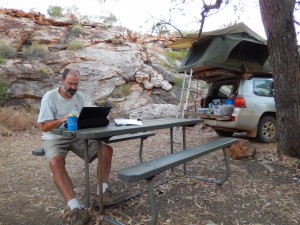
Writing for the blog from our camp in Bell Gorge, blissfully unaware of the python attack later that night
We had more gorges to visit in the next few days but the King Leopold Ranges and their surrounding slopes provided us with some dramatic vistas, beautiful gorges, deep swimming holes, ancient landscapes and stunning sunsets. Every moment in this region has been memorable.

